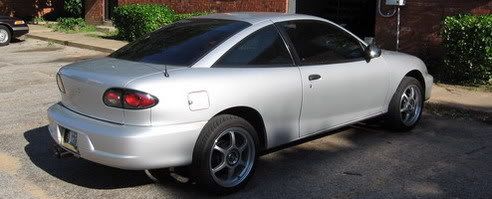ok i have a 1998 2.2 sedan with the 3spd. what numbers is the motor LD9 what i dont know domestic numbers i know sr20's and b18's but nothing else. and what is the actuall name for the tranny thanks
The ld9 is the 2.4 engine. The 2.2 that you have is ln2. those numbers are what GM calls RPO (Regular Production Option) codes. Look on the sticker under your factory spare tire cover, and there should be a whole list of every RPO your car came with from the factory, as well as the paint code.
Edited 1 time(s). Last edited Saturday, July 07, 2007 12:08 AM

I believe your trans is the 3T40E, which is a 3-spd auto w/ locking converter designed as a transverse-mounted transmission/axle with a Hydramatic Corporation load rating of 40 ( That's really light, in light of the fact the Northstar comes with a trans with a 80 rating. ) whose shift actuation valves are actually hydraulic circuit solenoids electronically controlled by the car's on-board computer ( PCM ). If I'm wrong anywhere here, someone please speak-up!
Go beyond the "bolt-on".
The northstar has a rating that high because the Caddies are heavy-ass boats, and the Northstars put out alot more power than any engine that GM would put the 3 speed behind. The 3 speed is capable of handling the power of our engines pretty well, but once you start making real power, it probably wouldn't live long.

I know that, Greg. I just couldn't remember the specific max-load ratings in ft-lbs for each code designation. If I remember an old HOT ROD article right, the 4L80E's 80 code stands for a 880ft-lbs max-load capability rating. Am I right, folks?
Go beyond the "bolt-on".
4 designates 4 speeds L designates longitudinal mount (rear drive) 80 designates 8000 lbs GVW and the E is electronically controlled. (supposedly it can handle more GVW, but 8k is what its rated at)
Pulled that from a Google search.
So using that, the 3T40 should be:
3 speed, transverse mount, 4000 lbs gross vehicle weight capacity.
Edited 5 time(s). Last edited Sunday, July 08, 2007 2:04 AM

Uh, I guess it's to late to mention that I meant in shearing-torque load. You know, where slippage between holding & held parts friction surfaces in excess of what's allowable begins to occur the trans while the unit is under load. Can you forgive me?
Go beyond the "bolt-on".
Well, that info I found seems to hold true, as for the shearing load, wouldn't GVW affect that somewhat? Engine torque would also be a factor as well as choice of fluid. Besides, a good shift kit and good, aftermarket clutch packs could easily increase those numbers. But, we are probably getting a bit esoteric and too in depth. haha.
Ok, now I'm tired. lol But anyhoo, thats how GM designates the auto-tranny names, and it would seem it holds true for most all of their auto trannies since the early 90's when they switched to that naming system (the 700R-4 renamed the 4L60 [which evolved into the 4L60-E thats in all the trucks now], and the THM-400 renamed the 3L80 [which evolved into the 4L80-E used in larger trucks, RV's, and tow-trucks] for examples). Hell, I even had in my possession at one time a THM-425 from a '74 Eldorado. I wonder how GM would have renamed THAT one if it was still made. 3LT425?

Man, reading up on that stuff makes me remember the days I was trying to save for a 4L80-E and controller kit to put in my '83 Chevy truck that kept popping trannies (first the original TH-350-C, then the built up 700R-4 I swapped in) from the power my engine was making. I finally said screw it, went to the dealership and traded it in for what you see in my sig. The rest is history.
And now I think I've rambled this topic way off-topic. Apologies.
Edited 1 time(s). Last edited Sunday, July 08, 2007 2:40 AM

It's cool... it's just good to be going in-depth again with someone who understands the machine this well. I guess I should mention at this point that what I was figuring as shearing-load was in relation to total-loading, where the output of the trans is held fixed and the input torque is slowly increased until friction slippage occurs.
Go beyond the "bolt-on".
Quote:
I just couldn't remember the specific max-load ratings in ft-lbs for each code designation.
There is no specific value to be derived from the naming of the trans. The 40, 60, 80 is a relative value. For illustration, the FWD 4T60 has a max GVW of 6400#, while the 4L60 longitudinal trans has a max GVW of 8600#.
-->Slow
The 4L60 won't live long in stock form while moving that much weight though without auxiliary cooling.

You're right on the money, Greg. Especially if the gearing in the rear is closer to 3.08 or 3.23. One of the biggest things GM did to help the 4L60(E) was admit the aftermarket had it right all along... more cooling! Around 95 or 96 GM stepped up to the plate by switching to 3/8" diameter cooler lines and matching fittings to allow fluid to get to the cooler faster. I personally don't like the 4L60 trans anyway, but that's just me.
-->Slow
personally i think the allision 1000 trans would be good in a j-body. haha






